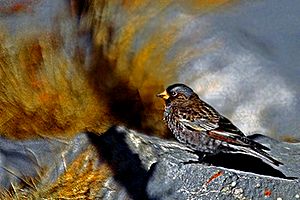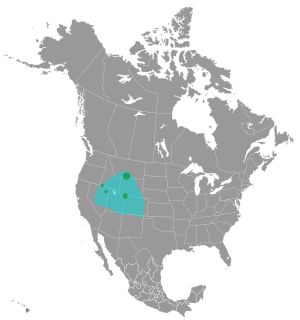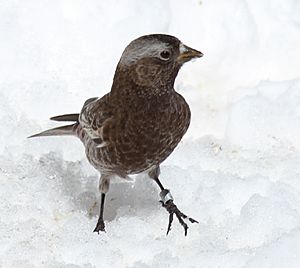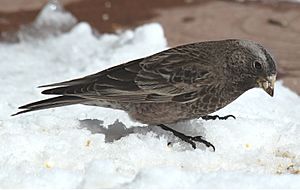Black rosy finch facts for kids
Quick facts for kids Black rosy finch |
|
|---|---|
 |
|
| Conservation status | |
| Scientific classification | |
| Genus: |
Leucosticte
|
| Species: |
atrata
|
 |
|
The black rosy finch (Leucosticte atrata) is a small bird that lives in the high mountains of the western United States. It's known for living in cold, rocky areas above the tree line, where trees can't grow. This bird is quite special because it's the only one of its kind that lives in such a specific, small area. Birdwatchers love to photograph it!
Contents
About the Black Rosy Finch
The black rosy finch was first described by an American bird expert, Robert Ridgway, in 1874. This bird is closely related to other "rosy finches" found in North America and Asia. These include the Gray-crowned rosy finch and the brown-capped rosy finch. Scientists once thought they were all the same species. However, DNA studies show they are very close relatives.
These birds belong to a group called Leucosticte, which means "mountain finch." There are no different types or subspecies of the black rosy finch. People in other countries have different names for it. For example, in French, it's called roselin. In German, it's Rußschneegimpel, and in Spanish, it's pinzón montano negro.
What Does It Look Like?
Adult black rosy finches have black feathers on their head, back, and chest. Their belly, rump, and parts of their wings are pink. They also have a gray patch on the back of their head. They have short black legs and a long, forked tail.
You can tell them apart from other rosy finches. The grey-crowned rosy finch has a brown body instead of black. The brown-capped rosy finch doesn't have the gray patch on its head.
Where Do They Live?
Black rosy finches live in mountain areas high above where trees grow. They prefer rocky cliffs and alpine areas. Because they live in such hard-to-reach places, they are one of the least studied birds in North America.
Their home range is between where the grey-crowned rosy finch lives (to the north and west) and where the brown-capped rosy finch lives (to the south and east).
How Do They Behave?
Black rosy finches build their nests in cracks or holes in cliffs. Their nests are shaped like a cup. Most of these birds migrate short distances. They move to lower, warmer places for winter and return to the high mountains in April.
These birds look for food on the ground. They might also fly to catch insects in the air. They mostly eat seeds from weeds and grasses, along with insects. They often find food in areas where snow is melting. This melting snow uncovers food items and new plant shoots. They usually feed in small groups. Sometimes, they even join groups of grey-crowned rosy finches.
During the breeding season, the male finch protects the female's territory. This means he defends not just the nest, but wherever she goes. This behavior is common among rosy finches. Both male and female birds develop special throat pouches when they are breeding. These pouches help them carry food back to their baby chicks. This is a rare trait in North American birds. Their call sounds like a buzzing "chew."
See also
 In Spanish: Pinzón montano negro para niños
In Spanish: Pinzón montano negro para niños




